
All electric heating companies will tell you that their heater is the most energy efficient or has the ‘potential’ to be the most efficient. And while all electric heaters are 100% efficient, some companies speak more truth than others when it comes to claiming their the most energy efficient heater on the market. To navigate through these claims, we delve into the world of the electric heaters, comparing various models to identify the most efficient options for heating your space.
The truth is: every electric heater on the market is ‘100% efficient’, yes even portable electric heaters. The reason being when they are switched on, the conversion from electricity to heat is 100% efficient. Compared to a gas central heating system that has energy wastage and can loose up to 40% of heat produced. However, many heating companies complicate the subject of electric heating efficiency by clouding the ‘real facts’ as they enthusiastically demonstrate the‘bells and whistles’ of their electric heaters and why their heating system is more efficient than the next one.
We know that all electric heaters are 100% energy efficient
If we take every type of electric heater on the market, including portable heaters, halogen heaters, fan heaters, convection heaters, etc., all of the same kilowatt (KW) and turn them all on for one hour, they will all use the same amount of electricity as each other, and the cost per hour will all be the same.
We do know though, that some electric heaters will warm up the room far faster than it’s opponent due to the way in which it transfers heat: using either radiant heat or convection. Unlike fan heaters, radiant and convection heaters offer advantages such as being practically silent and not blowing hot dust around, which makes them better for people with allergies and more suitable for certain room conditions.

Radiant heaters work by radiating heat into the room in short, straight lines, much like the way you can feel warmth from the sun’s rays. This means that whatever or whoever is in front of the heater will feel the warmth directly. Examples of radiant heating systems include infrared heaters, panel heaters, and halogen heaters. It’s important to note that radiant heaters do not transfer heat to the surrounding air. Therefore, if you want the whole room heating, the heater may need to be switched on for a longer period.
Convection heaters work by moving a mass of air away from the sources of heat carrying energy with it. Examples of convection heaters include storage heaters, oil-filled radiators, and fan heaters, each designed to circulate warm air throughout a room efficiently. Convected heat occurs because hot air expands and then becomes less dense and rises. Convection is the fastest way to warm up your room as the air moves around the room, therefore, it is seen as a faster way to heat any size room and won’t need to be turned on as long as a radiant heating system, this is where the potential for energy saving comes from.
We also realise that some electric heaters contain storage stones that retain heat and can maintain heat in the room without using supplementary energy.
There are two types of storage heaters, heaters that typically use the night-time electricity and a more modern equivalent that have been designed that you can use anytime of the day or night. This gives you much more controllability over energy consumption.

The more traditional storage heaters, known as night storage heaters, normally run on an Economy 7/Economy 10 tariff. This means that during the night they take advantage of the cheaper electricity rates (as you may be on an 18p day tariff and a 9p night tariff). The way these night storage heaters work is by using the night time tariff to warm up the storage stones through a heating element, the storage blocks then release the heat throughout the day.
The main disadvantages of the traditional night storage heaters are the set pattern of heat. You cannot turn it on or off at a whim if you are chilly or too warm - it will always release the heat on a set schedule. Therefore, when you are about to snuggle up and watch TV on an evening, they tend to run out of heat, so extra blankets and supplementary heating is needed. Due to the Economy 7 tariff, you will be paying twice as much on your daytime electric than your non-Economy 7 neighbour is.
We also know that the materials the electric heater is made from, may have slower conductivity than its opponent. Therefore, the time it takes to warm a room depends on the material of your electric heater.
How many times have you thought “It’s a bit chilly in here, is the heating on?” and then when you go and touch the radiator, it’s red hot? Then you go and switch up the thermostat believing that it will increase the room temperature quickly. That is because all heaters are made from different types of metals, and unfortunately, some metals don’t distribute heat evenly and quickly enough into the room.
An example of this: you are cold in the living room, so you turn your electric heater on. The heater starts to pull on the electricity to warm the heating elements, and then your heater starts warming up. The speed at which warm air is dispersed into the room depends on the metal from which the electric heater is made. This process is called conductivity. Conductivity, in layman terms, is the measure of the ability of a material (metal in this example) to transfer heat. The higher the temperature the metal reaches, the molecules will move more quickly. Metals that reach a higher temperature more rapidly will mean that the heat is transferred at a higher rate - thus, warming up your room faster - its more effective.
The main two types of metal that electric heaters are made from are mild steel and aluminium. The thermal conductivity of steel is much lower than that of aluminium. That means that the steel radiator needs to be on much longer than an aluminium radiator to warm up your room.
From the above facts you can see there are many factors that need to be considered when purchasing ‘energy efficient electric heating’.
A heater only becomes more efficient than its competitors if it more effective at warming up the room. Looking for the most energy efficient electric heater is the key to gaining efficient heating system. The faster and more effective the heater is at warming your room it wont need to be on as long. This means for you, less time switched on, less electricity usage. Ultimately, you will pay less on your electricity bill by having an electric heater that is more effective in your space. More effectiveness means better efficiency as it will not be on as long meaning it will loose less energy and you will save money.
When evaluating different models, it’s important not to get caught up in the technical jargon that budget electric heater companies often use to make their products seem more appealing. Wehn claiming that they offer ‘energy saving features’, consider whether your heater needs an “air purifier”, or “cold air setting”, and “ambient temperature control”. The only technical jargon you really need to be looking out for is “overheat protection”, and “adjustable thermostat” so you know you can control your electric heater safely. By understanding the practical impact of these features beyond the marketing speak, you can make a more informed decision that aligns with both your comfort and budget.
For a deeper comparison on different electric heating systems, their energy efficiency, energy usage, and running costs, check out our running cost guide. Our running cost guide was developed through out Knowledge Transfer Partnership (KTP) with the University of Huddersfield, so all the testing and results are independent and science backed.
Tags: Understanding Heating.

If you are considering electric heating/electric radiators, then this guide tells you everything you need to know. Discover this modern, sustainable and economical method of heating that gives you complete control and comfort. Download Free Guide now.

*Trust Electric Heating needs the contact information you provide to us to contact you about our products and services. You may unsubscribe from these communications at any time. For information on how to unsubscribe, as well as our privacy practices and commitment to protecting your privacy, check out our Privacy Policy.
Quick installation and a 100 day warmth guarantee. Whether you’re buying one or several radiators, if our radiators don’t heat your room to a minimum of 20 degrees we will undertake to upgrade or replace the radiators free of charge.
Book your free consultation